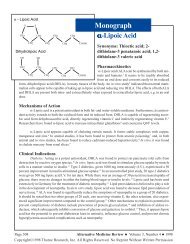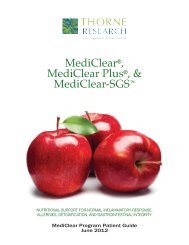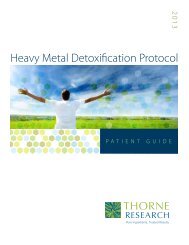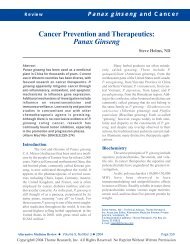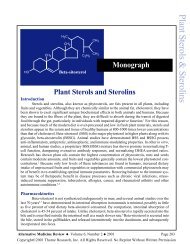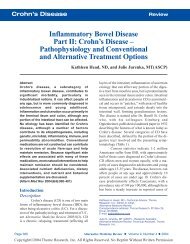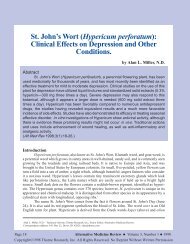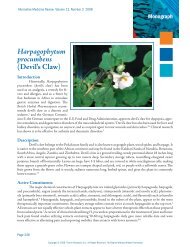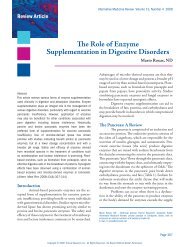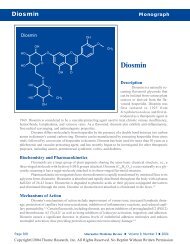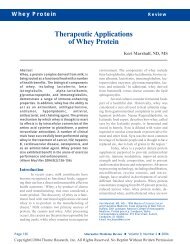Alternative Medicine Review - Thorne Research
Alternative Medicine Review - Thorne Research
Alternative Medicine Review - Thorne Research
- No tags were found...
Create successful ePaper yourself
Turn your PDF publications into a flip-book with our unique Google optimized e-Paper software.
Clinical Outcomes of a Diagnostic andTreatment Protocol in Allergy/SensitivityPatientsKonrad Kail, NDAbstractOBJECTIVES: This level II outcome study was conducted to examine the efficacy andtoxicity of a diagnostic and treatment protocol using electrodermal screening (EDS) inallergy/sensitivity patients. METHODS: Ninety-six patients with a diagnosis of allergyor sensitivity entered the study between 1994 and 1998; 90 participants completed thestudy. All participants followed the same protocol, and all interactions were with a singleclinician at a single site. The Allergy Symptom Severity Index (ASSI) was developed torecord symptomatic information. EDS – conductance measurement 1/Ω – of specificacupuncture points was used as an objective endpoint (indicator of outcome) and foridentification of antigens, according to Voll criteria. All measurements were taken beforeand after treatment, and EDS was carried out at all treatment sessions. Outcome criteriasuggesting efficacy were reduction in ASSI score, reduction in number of items testingpositive, and normalization of conductance measurements. A statistical analysis of theoutcomes was performed using the student’s paired t-test. RESULTS: There was astatistically significant change in pre- and post-treatment measurements of the ASSI.The conductance measurements normalized and the number of items testing positivedecreased compared to pre-treatment testing. In addition to these parameters, 87.2percent of subjects rated efficacy as good to excellent, and less than one-percent ratedthe outcome as poor. The outcome demonstrated longevity, meaning that people whohad their post-treatment evaluation up to three years after primary treatment were stillshowing minimal ASSI scores, with no additional treatment. The treatment appeared towork equally well across age groups and gender. Forty-eight percent of participantshad an aggravation of symptoms after treatment, lasting an average of 10 hours, withreactions described as mild to moderate. Average cost of the desensitization protocol(all costs included) was $822.16. CONCLUSIONS: This protocol demonstrated efficacywithout serious toxicity and no long-term adverse effects. It is natural, non-invasive,and does not require long periods of avoidance of offending foods or environmentalstimuli. The desensitization protocol is a low-cost, effective therapy for the treatment ofpatients suffering from symptoms of allergy/sensitivity disease.(Altern Med Rev 2001;6(2):188-202)Konrad Kail, ND – Advisory Council to the National Center for Complementary and <strong>Alternative</strong> <strong>Medicine</strong> at the NIH; Directorof the Southwest College <strong>Research</strong> Institute. Private practice, Naturopathic Family Care, Phoenix, AZ.Correspondence address: 13832 N 32nd Street Suite C24, Phoenix, AZ 85032. E-mail: kkail@home.comPage 188 <strong>Alternative</strong> <strong>Medicine</strong> <strong>Review</strong> ◆ Volume 6, Number 2 ◆ 2001Copyright©2001 <strong>Thorne</strong> <strong>Research</strong>, Inc. All Rights Reserved. No Reprint Without Written Permission
AllergiesIntroductionThe conductance (1/Ω) of acupuncturepoints varies and correlates with physiologicalchange and pathogenesis. The fact thatchange in the electrical field precedes morphologicchange, and manipulation of the electricalfield can affect the change, may shed lighton the diagnosis and treatment of many diseases.1 Studies have shown that a weak electricalDC stimulus evokes three mechanismsin the body: electrical conduction, dielectricpolarization, and self-regulation by an organicdefense system. The first two are physical; thethird is biological. When a direct current ofone volt is applied to the skin with electrodermalscreening (EDS), electrons and ions propelledby the circuit begin to move throughthe body. The mobility of electrons is influencedby cellular metabolism and the concentrationof charged particles suspended in bodyfluid. The net effect can be described using aresistance function of time. A constant, swiftchange takes place from the moment the circuitis closed until it reaches a final, steadystate. In addition to electrical conduction, thecells are polarized by the force of applied voltage.The charge on the cellular membrane willcause displacement in such a way as to producean opposing field. There is a slight separationbetween the positive and negativecharges, causing a small electric dipole in eachcell. All dipoles are aligned along the forcelines of external voltage. This alignment resultsin a dielectric polarization potentialagainst the voltage.Every living organism has defensemechanisms to protect itself from disturbance.Polarization induced by an external voltagewill provoke the cellular immune system. Theimmune system responds with an opposingbehavior, a net electric energy gradient or electromotiveforce (emf), which is brought aboutby complicated intracellular processes. Theseprocesses convert chemical energy (storedwithin the cells in the form of biomass) intoelectrical energy. It could be said the bodyfunctions as a resistor during the first 50 millisecondsfollowing the closing of the circuit,then as a semi-dielectric. 2The effect of these properties is thatmeridians have a smaller dielectric constantthan neighboring tissue. Because of this, electromagneticwaves move faster through meridiansthan through non-meridian tissue. It isthis combination of higher conductivity withlower polarizability that makes the meridiansystem an efficient bio-information communicationnetwork. That communication appearsto be transmitted into the tissues throughmeridian branches via the movement of ions,resulting in an electric current flowing betweenthe tissues and through the cellular membranegap junctions, a pathway of lower resistance. 3The meridian system and the regulativephysiological systems supplement andcomplement one another. Neither can be damagedwithout affecting the other. In a histologicalcomparison, the meridians are moreprimary and flexible than the differentiatedsystems, and can adjust more quickly to externalforces. Though the meridian system itselfdoes not have a definite physiologicalstructure, it creates and maintains structure, arole it plays for the entire life of the organism.These findings agree completely with the rulesof chi circulation in traditional Chinese medicine,including those expressed in The YellowEmperor’s Classic of <strong>Medicine</strong> (circa 100 BCalso referred to as the Neijing).In the 1950s, electrodermal screeningmethodologies were developed byacupuncturists in various countries in an effortto find inexpensive objective measurement ofthe changes observed in patients receivingacupuncture therapies. Electroacupunctureaccording to Voll (EAV) is the most versatile,precise, codified, and studied of the methodsdeveloped. Dr. Voll and others have gatheredclinical data suggesting that electricalconductance measurements taken at lowresistance points on the body can be correlated<strong>Alternative</strong> <strong>Medicine</strong> <strong>Review</strong> ◆ Volume 6, Number 2 ◆ 2001 Page 189Copyright©2001 <strong>Thorne</strong> <strong>Research</strong>, Inc. All Rights Reserved. No Reprint Without Written Permission
to the bio-energetic functional status of specificorgans and tissue systems. 4 Many of the lowresistance measurement points correlate withclassical acupuncture points. It has beenobserved that pathological disturbances oforgan function established by conventionalmedical diagnostic procedures are frequentlyreflected by disturbed skin conduction valuesat corresponding points suggested byacupuncture theory. 5-7 An abnormalmeasurement at a point should therefore besuggestive of a functional disturbanceassociated with its corresponding organ orsystem.The electrodermal screening device(EDSD) is an ohmmeter designed to deliverapproximately 10-12 µa DC at 1-1.25 v,through a probe or electromagnetic coil. Thesignal is below the level of human sensation.On the majority of devices the meter is calibratedto read from 0-100, such that the standardskin resistance of 100 mΩ reads 50. Theminimum value of zero represents infinite resistance(no electrical conductivity), and themaximum value of 100, zero resistance at thegiven voltage and current. 8A reading taken with the EDSD is usuallydescribed using two values, the initialreading (peak) and the indicator drop (ID). Apeak reading of about 50 with ID
Allergieselicit findings to show that the energy of somesubstances will balance the energy of the acupuncturepoint (therapeutic), and the energyof other substances will imbalance the energyof the acupuncture point (adverse). Administeringan EDSD energy challenge of specificantigenic allergens to acupuncture points andrecording the energy response is completelyanalogous to the challenge and response seenin skin and/or RAST testing.The use of EDS to diagnose allergiesand sensitivities has been studied. In one study30 volunteers were analyzed for food intoleranceusing five standard diagnostic methods(history, skin test, RAST test, IgE, and foodchallenge) compared to EDS. EDS results correlatedstrongly with the results of the otherfive methods. EDS showed the closest correlationwith food challenge (considered by allergiststo be the most reliable). 11 When EDSis used for sensitivity diagnosis, a peak readingof 58 or less with an indicator drop of >2when challenged with a substance is consideredpositive (a reacting substance).HypothesisPeople become sensitized to substancesdue to a breakdown in barrier functions(skin, mucus membranes, and digestion),which allows larger molecules into the bloodstreamthan would normally appear there, thustriggering a sensitivity response which causesinflammatory chemical release and resultingallergic symptoms. Sensitivity is diagnosed bydemonstrating that the energy replication of aspecific substance causes a drop in electricalconductance at specific acupuncture points. Ahomeopathic remedy of the substances towhich the subject was found to be sensitivecan be electromagnetically created to serve asthe stimulus to the subject. Desensitization ofthe subject can be achieved by: (1) stimulatingthe subject with the homeopathic remedycausing the subject’s brain to identify the offendingenergies and attack them; (2) balancingthe energy using a specific acupressuretherapy, which causes the brain to stop attackingbecause the energy has become normalized;and (3) maintaining the new energy statefor a critical period (24 hours), creating a new“default setting” for the brain, which no longersees the antigens as a threat and stops futureattacks, as long as barrier functions are repairedand maintained.<strong>Research</strong> Objectives1. To demonstrate that desensitizationtreatment results in a significant lessening ofsymptoms in subjects with allergy/sensitivitydiagnoses as shown by subjective evaluationusing the Allergy Symptom Severity Index(ASSI).2. To demonstrate that desensitizationtreatment results in a reduction of antigensfound to be positive on objective sensitivityscreening using the EDS system.3. To demonstrate that desensitizationtreatment results in normalization of electrodermalscreening (conductance) measurements.Materials and MethodsEntry Criteria: any age, gender, or severitywith an established diagnosis of allergy/sensitivity disease. Ninety-six patients enteredthe study between 1994 and 1998. All weresurveyed, and 90 participants completed thestudy with full data sets. All participants followedthe same protocol, and all interactionswere with a single clinician, at a single site.Informed consent was given by all participants.Testing and Treatment ProcedureThe ASSI was developed to recordsymptomatic information. It is a listing of 41allergy/sensitivity symptoms obtained from themedical literature. Each symptom is graded ona scale from 1-5, with 1 representing nosymptoms and 5 representing severe orconstant symptoms. (see page 201 for ASSIquestionnaire)<strong>Alternative</strong> <strong>Medicine</strong> <strong>Review</strong> ◆ Volume 6, Number 2 ◆ 2001 Page 191Copyright©2001 <strong>Thorne</strong> <strong>Research</strong>, Inc. All Rights Reserved. No Reprint Without Written Permission
Figure 1: Location of Treatment PointsElectrodermalscreening (conductancemeasurement 1/Ω) ofspecific acupuncturepoints was used as an objectiveendpoint (indicatorof outcome) and foridentification of antigens,according to Vollcriteria. All measurementswere taken beforeand after treatment; andEDS was carried out atall treatment sessions.The EDSD used was theComputron manufacturedby Computronix(Synergy Health Systems,1223 WilshireBlvd. #321, SantaMonica, CA 90403)with the Acupro II softwarepackage. This device(and several others)performed according toparameters establishedby Dr. Voll. 12Large IntestineLungLymphDesensitizationProtocolThis system uses change in electricalconductance measurements as the indicator ofnegative body response or sensitivity, in orderto determine to which antigens the subject isreacting. The energetic replications of thoseantigens can then be “imprinted” through anelectromagnetic coil onto lactose pellets,which is much like charging a battery. Thiscreates an “all-C potency”(contained all the cpotencies 1c, 2c, 3c, etc.) homeopathic remedyof the offending substances.By having the subject hold the remedy,the homeopathic medicine is then used tostimulate a response in the subject. Since energyis not a physical substance but a field, itNerve• AL1B - ENTIRE BODY• AL1 - FOOD• AL1A - CHEMICALS AFFECTING ANS• AL1C - HEAVY METALS• AL2 - INHALANTS AFFECTING LUNGS• AL3 - INHALANTS AFFECTING HEENT• AL4 - CHEMICALS AFFECTING CNSCirculation AllergyOrganTriple-warmerHeartSmall Intestinegoes beyond the bounds of the physical container.(Consider Kirlian photographs andother demonstrations of energy fields.) Thesubstance and the subject’s energy fields interact,which upsets the energy in the subject,creating an alarm message in the brain, whichthen initiates a response to attack the offendingagent. In order to attack something, biologicalsystems must somehow identify theinvader (the brain knows specifically whatsubstances are represented by the energy). Theattack response often causes aggravatingsymptoms in the subject, usually manifestingas mild to moderate worsening of the allergy/Page 192 <strong>Alternative</strong> <strong>Medicine</strong> <strong>Review</strong> ◆ Volume 6, Number 2 ◆ 2001Copyright©2001 <strong>Thorne</strong> <strong>Research</strong>, Inc. All Rights Reserved. No Reprint Without Written Permission
Allergiessensitivity symptoms the subject was alreadyexperiencing and typically lasting 6-24 hours.Demonstration that a response hasbeen initiated is achieved by showing muscleweakness in the subject while holding the homeopathicremedy. Standard acupressure isthen applied to specific acupuncture pointsalong the bladder and Huatuo Jiagi meridians,which balances or corrects the energy of thesystem. This is demonstrated by a return ofmuscle strength to the subject, even thoughcontact is still maintained with the homeopathicremedy. This indicates that a new responseto the substances represented in thehomeopathic remedy has been achieved.A series of four treatments (one/week)is performed: the first for inhalants (pollens,danders, smoke, smog, etc.); the second forcontact allergens (mostly chemicals); a thirdfor foods, and a fourth treatment when all itemsare retested to “clean-up” anything remaining.There are over 1,500 generic items tested, aswell as actual items sampled from the home/work environment.<strong>Research</strong> ProcedureAfter obtaining a signed informed consentform and completion of an ASSI questionnaire,the desensitization protocol was carriedout. At the initial evaluation, a medicalhistory was taken and the following data wasgathered: symptom surveys, a first morningurine specimen, basal body temperatures, anda transit time. At the second visit a regionalphysical exam was performed and findingswere reported. Therapy for support and repairof barrier (gut, mucus membranes, and skin)and associated organ dysfunctions was given.On the third visit electrodermal screeningfor allergy/sensitivity was performed. Infantsand small children were tested through asurrogate (usually a parent). Figure 1 illustrateslocation of allergy/sensitivity meridian points.Sensitivity testing of inhalant allergenswas performed, as well as sensitivity testingof dirt samples from the home/work environment.A homeopathic remedy (all-C) of itemstesting positive was prepared. Strength testingof the anterior head of the deltoid – nullstate – was performed. Administration (holding)of the homeopathic remedy by the subjectserves as a stimulus, which is seen by thesubject’s brain and immune system as an adverseevent, influencing the system response.Evidence of this adverse effect is seen byweakening of the deltoid muscle on repeatstrength testing.A standard acupressure treatment wasthen performed to balance specific meridiansusing the following points:• To balance the left lung: bladder 11, Yishu,bladder 23, bladder 26• To balance the right lung: bladder 12, bladder18, bladder 24, bladder 26• To balance the spleen: bladder 11, bladder15, bladder 18• To balance the stomach: Yishu, bladder 19,bladder 20• Huatuo Jiagi points overlapping the spinalsegments balance the energy in specificmeridians.According to Voll, balance is a readingof 50 on the meter.The acupuncture treatment resulted inbalancing the energy of the entire systemaround the offending energies (the homeopathicremedy) the subject was holding. Evidenceof a therapeutic effect can be seen bystrengthening of the deltoid muscle on repeatmuscle testing. The remedy was then kept incontact with the subject’s skin for 15 minutesto preserve the new energy state. It is necessaryto avoid all contact with items found tobe positive on sensitivity testing and any extremethat may upset the subject’s energy dramaticallyfor one cycle of the horary clock (24hours) in order for the new energy state to bemaintained.<strong>Alternative</strong> <strong>Medicine</strong> <strong>Review</strong> ◆ Volume 6, Number 2 ◆ 2001 Page 193Copyright©2001 <strong>Thorne</strong> <strong>Research</strong>, Inc. All Rights Reserved. No Reprint Without Written Permission
Table 1: Study DemographicsDEMOGRAPHICSCAUCASIAN 97%HISPANIC 1.5%ASIAN 1.5%MALEFEMALE55 553.0% 13.6% 4.5% 19.7% 51.5% 7.6%On the fourth visit, electrodermalscreening was performed for sensitivity tophenolics, heavy metals, pesticides, herbicides,antibiotics and other conventionalmedications, vaccinations, dental materials,cosmetics, cleaning supplies, paints,and other items found in the home environment.Otherwise treatment was performedas in the third visit.On the fifth visit, electrodermalscreening was performed for sensitivitytesting of foods. Otherwise treatment wasperformed as in the third visit.On the sixth visit, electrodermalscreening was performed for retesting of sensitivityto all previously tested items, as wellas sensitivity testing of other items from thehome environment (hats, sunglasses, pillows,stuffed animals, toys, etc.). Otherwise treatmentwas performed as in the third visit. Subsequentevaluations were on a demand basisand were carried out as in the sixth visit.The outcomes evaluation was performedby a re-administration of the ASSIquestionnaire and a final EDS (conductance)measurement. The data were then evaluatedby a statistician.Figure 2: Median Pre- and Post-desensitizationScores on ASSI.9080706050403020100Pre-Treatment ScorePost-Treatment ScoreA.S.S.I.ResultsSubjectiveForty-one allergy/sensitivitysymptomswere recorded,using ASSI before andafter treatment withthe desensitizationprotocol. Ninety-sixpatients participatedwith 90 completing thestudy. See Table 1 fordemographics. Astudent’s paired t-testwas used on the datawith the 95-percentconfidence limit(p=0.05). Thirty-nineof the 41 symptomsshowed a statisticallysignificant drop in severitywith most (36/41) having a statisticalPage 194 <strong>Alternative</strong> <strong>Medicine</strong> <strong>Review</strong> ◆ Volume 6, Number 2 ◆ 2001Copyright©2001 <strong>Thorne</strong> <strong>Research</strong>, Inc. All Rights Reserved. No Reprint Without Written Permission
AllergiesFigure 3: Relative Severity of the Worst Allergy SymptomScores on ASSI3.532.521.51SinusitisFlatulenceFatigueRunny noseIncreased mucusItchingDark circles @ eyesEasily upsetDry skinBelchingCough0.50Symptomsignificance (p
Figure 4: Pre- and Post-treatment Scores by Season1401201008060Pre-treatmentPost-treatmentChange40200JAN-MAR APR-JUN JULY-SEPT OCT-DECFigure 5: Average ASSI Scores Following Initial Treatment50454035302520A.S.S.I. Score reduction151050Recent 6 months 1 year 2 years 3 yearsPage 196 <strong>Alternative</strong> <strong>Medicine</strong> <strong>Review</strong> ◆ Volume 6, Number 2 ◆ 2001Copyright©2001 <strong>Thorne</strong> <strong>Research</strong>, Inc. All Rights Reserved. No Reprint Without Written Permission
AllergiesFigure 6: Patient Rating of Desensitization Efficacy50454035302520Efficacy (%)151050Excellent Good OK PoorIncluding the basic series and all subsequenttreatments, the average number oftreatments was 10.52, with an average of 3.62visits/year, including the four to five initialscreening visits; therefore, subsequent yearsinvolved fewer visits. It took an average of 2.6treatments before the patient started to experiencerelief of symptoms.Patients reported an average level ofcompliance with the protocol as 1.60 withscores of 1=excellent, 2=good, 3=OK, 4=poor,and 5=non-compliant. Using the same ratingscale, the patients rated the success of the protocolat 1.67. Efficacy of the protocol was ratedas excellent by 46.7 percent of patients, goodby 42.1 percent, OK by 6.8 percent, and poorby one percent (Figure 6).ObjectiveInitial pre-treatment EDS conductancemeasurements are shown in Figure 7. Maximum,minimum, and median values are shown.The normal range is 50-65, with 50 representingbalance of the point/meridian. The followingEAV points were used: AL1B was the controlmeasurement point for measuring a generalreaction; the point AL1 was for measuringfood reactions; AL1-1 point was used tomeasure toxic foci; the AL1A point measuredcontacted chemicals; AL1C measured metals;AL2 point was used to measure inhalants affectingthe lungs; the AL3 point measured inhalantsaffecting the nose and sinuses; AL3Apoint measured autoimmune responses; andthe AL4 point measured cerebral reactions.The pre-treatment conductancemeasurements of participants showedsignificant variation among points. Thebalance point is 50. Higher conductancemeasurements reflect increasing inflammatoryresponse (excess energy) in the point/meridian.<strong>Alternative</strong> <strong>Medicine</strong> <strong>Review</strong> ◆ Volume 6, Number 2 ◆ 2001 Page 197Copyright©2001 <strong>Thorne</strong> <strong>Research</strong>, Inc. All Rights Reserved. No Reprint Without Written Permission
Figure 7: Pre-treatment Conductance MeasurementsPRE-TREATMENT EDS10075Conductance50250AL1BGENERALAL1 FOODSAL1-1TOXINSAL1ACHEMICALSAL1CMETALSAL2INHALANTS(LUNGS)AL3INHALANTS(SINUS)MAXIMUM 65 81 62 73 62 76 77MEDIAN 56.2 51.6 53.2 51.3 52.1 53.7 53.1MINIMUM 41 30 46 34 45 40 37Lower conductance measurements reflect anexhausted (deficient energy) point/meridian;both are undesirable.The post-treatment conductance measurementsof participants showed a balancingof the energies in the acupuncture points, indicatinga return to normal or less reaction toantigens. There is less variation point to pointand the conductance measurements are closerto 50 as shown in Figure 8.Indicator drop is a measure of chronicityor degenerative change. In Figure 9 indicatordrop stabilizes as treatment progresses.The cleanup and post-treatment values weremeasured weeks to months later and show stabilizationat a low-level indicator drop. This ispostulated to be due to short-term sensitivitiesthat come and go related to digestive andother transitory problems like infections.Changes in conductance measurementat AL1B after the desensitization procedurewere approximately the same in all ages andfor both genders.The number of antigens, divided bytype of allergen, testing positive on initial EDSmeasurements is shown in Figure 10. Initially,the total number of antigens testing positivewas a maximum of 322, a minimum of 22,with an average of 164. The post-treatmentantigens testing positive ranged from a maximumof 26, to a minimum of 1 with an averageof 12.9 – a greater than 10-fold change asdepicted in Figure 11.Page 198 <strong>Alternative</strong> <strong>Medicine</strong> <strong>Review</strong> ◆ Volume 6, Number 2 ◆ 2001Copyright©2001 <strong>Thorne</strong> <strong>Research</strong>, Inc. All Rights Reserved. No Reprint Without Written Permission
AllergiesFigure 8: Post-treatment Conductance MeasurementsPOST-TREATMENT EDS80706050Conductance403020100AL1BGENERALAL1 FOODSAL1-1 TOXINSAL1ACHEMICALSAL1C METALS AL2 LUNGSMAXIMUM 69 73 66 73 66 62MEDIAN 56.3 60 58.1 55.8 56.4 51.2MINIMUM 43 43 50 44 44 32Meridian PointsFigure 9: Indicator Drop as Treatment Progresses876543210Inhalants Contactants Foods Cleanup Post-treatment<strong>Alternative</strong> <strong>Medicine</strong> <strong>Review</strong> ◆ Volume 6, Number 2 ◆ 2001 Page 199Copyright©2001 <strong>Thorne</strong> <strong>Research</strong>, Inc. All Rights Reserved. No Reprint Without Written Permission
140120100806040200350300250200150100500Figure 10: Pre-treatment Antigens TestingPositive Divided by Type of Allergen14074.25145815.25412474.5Inhalants Contactants FoodsFigure 11: A Comparison Between Numberof Positive Antigens Pre- and Post-treatment322154PRE-TREATMENT ANTIGENSPOSITIVE22 2612.9 1POST-TREATMENTANTIGENS POSITVE4MaximumMedianMinimumMaximumMedianMinimumSafety and CostEffectivenessPatients experiencedan aggravationof their symptoms aftertreatments on theaverage 54.2 percent ofthe time. Typical symptomsincluded fatigue,itching, congestion,sneezing, headache,upper respiratory problems,sinus pain, andwheezing. The severityof symptoms was describedas mild(57.8%), moderate(33.3%), or severe(8.9%). All reactionswere treated at homewith previously prescribedagents andnone required physicianintervention. Theaverage length of aggravationwas 33.6hours. Some peoplecould not maintain theenergy correction andhad to have a treatmentrepeated; thisoccurred in 48.2 percentof cases.The averagetotal cost (visits, testing,support supplements,and treatment)was $822.16. This includeda statisticalanomaly of one personwho had manymore treatments thanaverage. Patients reporteddiscontinuingPage 200 <strong>Alternative</strong> <strong>Medicine</strong> <strong>Review</strong> ◆ Volume 6, Number 2 ◆ 2001Copyright©2001 <strong>Thorne</strong> <strong>Research</strong>, Inc. All Rights Reserved. No Reprint Without Written Permission
AllergiesNatural Elimination of Allergy TherapyAllergy Symptom Severity Index(A.S.S.I.)Name: __________________________Date: ______________Grade the level of symptom severity that you are currently experiencingaccording to the following system:1 = NO PROBLEM2 = RARELY (ONCE A MONTH) OR MINIMAL3 = OCCASIONAL (ONCE A WEEK) OR MILD4 = FREQUENT (SEVERAL TIMES A WEEK) OR MODERATE5 = DAILY OR SEVEREINTEGUMENT-MUSCULOSKELETAL_____ Dark circles around eyes_____ Itching, burning, painful skin_____ Flaking skin_____ Dry skin_____ Skin rash_____ Oozing or crust formation_____ Hair loss_____ Muscle cramps_____ Painful, stiff or swollen joints_____ Migraines_____ Total for sectionEYE, EAR, NOSE, THROAT-RESPIRATORY_____ Itching, burning, red, or watery eyes_____ Runny nose_____ Increased mucus production_____ Sinus congestion or headache_____ Scratchy or sore throat_____ Itchy ears, snapping, popping, pain_____ Cough_____ Frequent colds or ear infections_____ Shortness of breath_____ Wheezing or coughing in fits_____ Total for sectionCARDIOVASCULAR-GASTROINTESTINAL_____ Heart racing_____ Palpitations (skipped beats)_____ Upper bowel gas (belching)_____ Lower bowel gas (flatulence)_____ Reflux (heartburn)_____ Bloating; abdominal distention_____ Liquid stools_____ Greasy stools_____ Mucus in stools_____ More than 3 stools per day_____ Total for sectionMENTAL-EMOTIONAL_____ Difficulty remembering_____ Blackouts_____ Numbness or tingling_____ Want to be alone_____ Don’t care about appearance_____ Fatigue, no energy_____ Easily upset_____ Inappropriate anger_____ Undue fears_____ Problems with appetite or sleep_____ Total for sectionA.S.S.I. TOTAL SCORE _________<strong>Alternative</strong> <strong>Medicine</strong> <strong>Review</strong> ◆ Volume 6, Number 2 ◆ 2001 Page 201Copyright©2001 <strong>Thorne</strong> <strong>Research</strong>, Inc. All Rights Reserved. No Reprint Without Written Permission
or decreasing pharmaceutical medication 52.2percent of the time, and 69.3 percent were ableto suspend office visits after treatment. Positiveside effects (something improved thatwasn’t anticipated or explained by the therapy)occurred 42.1 percent of the time. For example,people had a lot more energy after treatment.Alleviation of fatigue was an unexpected positiveeffect, as most people don’t equate fatigueas being due to allergy.ConclusionsThere was a statistically significantchange in ASSI scores, EDS conductance measurements,and number of items testing positiveafter treatment, suggesting efficacy of thedesensitization protocol. The procedure isnatural, noninvasive, does not require longperiods of abstinence, is safe, and free fromlong-term side effects. Perhaps the most interestingfinding is that these changes wereaccomplished with the application ofacupressure, and use of homeopathic remedieswhich were never ingested by the participants.All changes occurred purely from an energytherapy. The only medications given were tosupport gut barrier integrity, digestive function,mucus membrane integrity, skin health,and organ balancing, in order to prevent resensitization.The desensitization protocol isa low cost, effective therapy for the treatmentof patients suffering allergies and sensitivities.AcknowledgementsSpecial thanks to Robert F. Waters,PhD., Director of the Southwest College <strong>Research</strong>Institute (SCRI) for the statistical analysisof the data. Thanks also to Linda Kim, ND,Associate Director of SCRI for statistical supportand to the faculty, staff, and students ofthe Southwest College of Naturopathic <strong>Medicine</strong>.Thanks to the American Association ofAcupuncture and Bioenergetic <strong>Medicine</strong>(AAABEM) for providing the investigationalreview board and monitoring the research.References1. Shang C. Mechanism of acupuncture – beyondneurohumoral theory. Med Acupunct1999;11:1-14.2. Chen K. Electrical properties of meridians.IEEE Eng Med Biol 1996;15:58-63.3. Jingyu F, Shiyuan X, Zhe L, Zhemei W. Therole of gap junctions in determining skinconductance and their possible relationship toacupuncture points and meridians. Am JAcupunct 1990;18:163-170.4. Voll R. Twenty years of electroacupuncturediagnosis in Germany: a progress report. Am JAcupunct 1975;3:7-17.5. Tsuei J, Lam F, Chou P. Clinical applicationsof the EDST. IEEE Eng Med Biol1996;15:3:67-75.6. Motoyama M. Measurements of Ki EnergyDiagnosis & Treatments – Treatment Principlesof Oriental <strong>Medicine</strong> from an ElectrophysiologicalViewpoint. Tokyo, Japan: HumanScience Press; 1997.7. Motoyama M. Comparisons of DiagnosticMethods in Western & Eastern <strong>Medicine</strong>. ACorrelation Between Ki Energy and EnvironmentalConditions. Tokyo, Japan: HumanScience Press.8. Tsuei J. The past, present and future of theelectrodermal screening system (EDSS), J AdvMed 1995;8:217-232.9. Petzold C. Code – The Hidden Language ofComputer Hardware and Software. Redmond,WA: Microsoft Press; 1999:72.10. Chen K. Applying quantum interference toEDST medicine testing. IEEE Eng Med Biol1996;15:3:64-66.11. Tsuei J, Lehman C, Lam F, Zhu D. A foodallergy study utilizing the EAV acupuncturetechnique. Am J Acupunct 1984;12:105-116.12. Lam F, Tsuei J, Zhao Z. Studies in bioenergeticcorrelations – bioenergetic regulatorymeasurement instruments and devices. Am JAcupunct 1988;16:345-349.Page 202 <strong>Alternative</strong> <strong>Medicine</strong> <strong>Review</strong> ◆ Volume 6, Number 2 ◆ 2001Copyright©2001 <strong>Thorne</strong> <strong>Research</strong>, Inc. All Rights Reserved. No Reprint Without Written Permission



